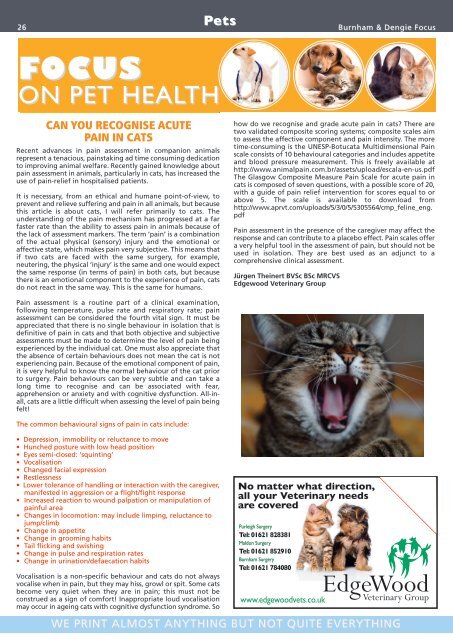Burnham focus 143 copy
Create successful ePaper yourself
Turn your PDF publications into a flip-book with our unique Google optimized e-Paper software.
<strong>copy</strong> <strong>focus</strong> <strong>143</strong>.qxp_Layout 1 20/04/2018 12:56 Page 26<br />
26<br />
Pets<br />
<strong>Burnham</strong> & Dengie Focus<br />
FOCUS<br />
ON PET HEALTH<br />
CAN YOU RECOGNISE ACUTE<br />
PAIN IN CATS<br />
Recent advances in pain assessment in companion animals<br />
represent a tenacious, painstaking ad time consuming dedication<br />
to improving animal welfare. Recently gained knowledge about<br />
pain assessment in animals, particularly in cats, has increased the<br />
use of pain-relief in hospitalised patients.<br />
It is necessary, from an ethical and humane point-of-view, to<br />
prevent and relieve suffering and pain in all animals, but because<br />
this article is about cats, I will refer primarily to cats. The<br />
understanding of the pain mechanism has progressed at a far<br />
faster rate than the ability to assess pain in animals because of<br />
the lack of assessment markers. The term ‘pain’ is a combination<br />
of the actual physical (sensory) injury and the emotional or<br />
affective state, which makes pain very subjective. This means that<br />
if two cats are faced with the same surgery, for example,<br />
neutering, the physical ‘injury’ is the same and one would expect<br />
the same response (in terms of pain) in both cats, but because<br />
there is an emotional component to the experience of pain, cats<br />
do not react in the same way. This is the same for humans.<br />
how do we recognise and grade acute pain in cats? There are<br />
two validated composite scoring systems; composite scales aim<br />
to assess the affective component and pain intensity. The more<br />
time-consuming is the UNESP-Botucata Multidimensional Pain<br />
scale consists of 10 behavioural categories and includes appetite<br />
and blood pressure measurement. This is freely available at<br />
http://www.animalpain.com.br/assets/upload/escala-en-us.pdf<br />
The Glasgow Composite Measure Pain Scale for acute pain in<br />
cats is composed of seven questions, with a possible score of 20,<br />
with a guide of pain relief intervention for scores equal to or<br />
above 5. The scale is available to download from<br />
http://www.aprvt.com/uploads/5/3/0/5/5305564/cmp_feline_eng.<br />
pdf<br />
Pain assessment in the presence of the caregiver may affect the<br />
response and can contribute to a placebo effect. Pain scales offer<br />
a very helpful tool in the assessment of pain, but should not be<br />
used in isolation. They are best used as an adjunct to a<br />
comprehensive clinical assessment.<br />
Jürgen Theinert BVSc BSc MRCVS<br />
Edgewood Veterinary Group<br />
Pain assessment is a routine part of a clinical examination,<br />
following temperature, pulse rate and respiratory rate; pain<br />
assessment can be considered the fourth vital sign. It must be<br />
appreciated that there is no single behaviour in isolation that is<br />
definitive of pain in cats and that both objective and subjective<br />
assessments must be made to determine the level of pain being<br />
experienced by the individual cat. One must also appreciate that<br />
the absence of certain behaviours does not mean the cat is not<br />
experiencing pain. Because of the emotional component of pain,<br />
it is very helpful to know the normal behaviour of the cat prior<br />
to surgery. Pain behaviours can be very subtle and can take a<br />
long time to recognise and can be associated with fear,<br />
apprehension or anxiety and with cognitive dysfunction. All-inall,<br />
cats are a little difficult when assessing the level of pain being<br />
felt!<br />
The common behavioural signs of pain in cats include:<br />
• Depression, immobility or reluctance to move<br />
• Hunched posture with low head position<br />
• Eyes semi-closed: ‘squinting’<br />
• Vocalisation<br />
• Changed facial expression<br />
• Restlessness<br />
• Lower tolerance of handling or interaction with the caregiver,<br />
manifested in aggression or a flight/fight response<br />
• Increased reaction to wound palpation or manipulation of<br />
painful area<br />
• Changes in locomotion: may include limping, reluctance to<br />
jump/climb<br />
• Change in appetite<br />
• Change in grooming habits<br />
• Tail flicking and swishing<br />
• Change in pulse and respiration rates<br />
• Change in urination/defaecation habits<br />
Vocalisation is a non-specific behaviour and cats do not always<br />
vocalise when in pain, but they may hiss, growl or spit. Some cats<br />
become very quiet when they are in pain; this must not be<br />
construed as a sign of comfort! Inappropriate loud vocalisation<br />
may occur in ageing cats with cognitive dysfunction syndrome. So<br />
WE PRINT ALMOST ANYTHING BUT NOT QUITE EVERYTHING


















